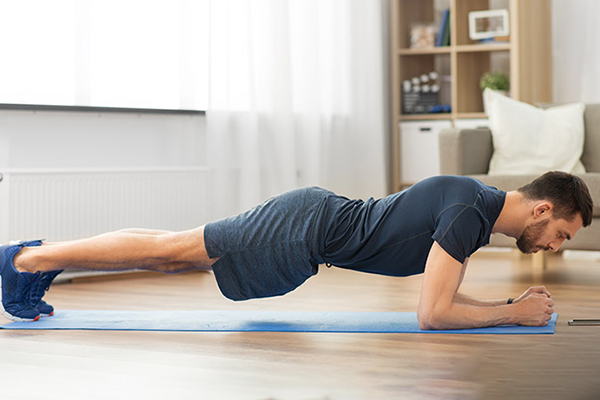The plank exercise has gained widespread popularity as one of the most effective ways to enhance your core strength and abdominal muscles while also improving overall body balance. This exercise is a staple in yoga routines and is highly favored by fitness trainers. Regardless of whether you’re a novice or a seasoned gym enthusiast, planks are frequently recommended due to their numerous benefits.
Now, a common question that arises is whether the plank exercise has any impact on one’s height. In this comprehensive article, we will provide you with all the essential information about planks. So, let’s delve into it!
How do planks get so popular today?
The rapid rise in the popularity of planks within the fitness community can be attributed to their remarkable effectiveness in targeting the abdominal muscles. Unlike many other exercises that involve dynamic movements, the plank focuses on engaging the abdominal muscles by requiring them to remain stable and not move. This unique approach aligns perfectly with the intended function of the abdominal muscles. Furthermore, planks contribute to maintaining core muscle stability, which plays a pivotal role in promoting proper posture, ensuring a straight and aligned spine. Additionally, planks offer the added benefit of strengthening the shoulders and hips, thereby enhancing overall balance, especially when incorporating variations that involve the arms or legs.
One of the outstanding features of the plank exercise is its safety. It primarily employs neutral spine loading rather than trunk flexion to target the abdominal muscles. This makes it a low-risk exercise that can be performed virtually anywhere, without the need for gym equipment or specialized gear. The convenience and accessibility of planks make them an ideal choice for individuals seeking to improve their core strength and overall fitness without the constraints of a gym environment.
In conclusion, the plank exercise has garnered widespread acclaim in the fitness world due to its ability to effectively target core muscles, enhance posture, and promote overall balance. Whether you’re a fitness enthusiast or just starting your fitness journey, incorporating planks into your routine can provide a multitude of benefits. So, why wait? Start planking today for a stronger core and a more balanced body!

Can you get taller by doing plank exercises?
As of now, there is no conclusive evidence to suggest that engaging in plank exercises can lead to an increase in your height. However, this doesn’t mean you should dismiss the benefits of incorporating planks into your fitness routine.
Plank exercises can have a positive impact on your overall well-being, particularly in terms of posture improvement. Maintaining proper posture is crucial for several reasons. Firstly, it helps in ensuring that your bones remain properly aligned, reducing the likelihood of skeletal injuries. Additionally, good posture distributes the stress on your joints and bones more evenly, thus minimizing the risk of discomfort and pain.
Furthermore, plank exercises are effective in strengthening your core muscles. This increased core strength can be advantageous in preventing hunching while sitting or standing. By fortifying your core, you’ll find it easier to maintain an upright position, which contributes to a more confident and taller appearance, even if it doesn’t directly affect your actual height.
In conclusion, while plank exercises may not make you physically taller, they can certainly enhance your posture and core strength, ultimately leading to a more poised and erect stance that can give the illusion of increased height. So, incorporating planks into your fitness routine remains a worthwhile endeavor for overall health and well-being
How to do a plank exercise?
Here is a simple step-by-step approach to practicing a basic plank pose for newbies.
- Begin with your body facing down on the floor and your hands directly under your shoulders.
- Use your toes to push your body upward and keep your chin tight to your neck.
- Make sure your body is in a straight line from your head to your toes.
- Avoid rising or lowering your hips too low and try to keep your hips straight.
- Look down and hold it for about 20 seconds.
The plank is also versatile in the number of different ways you can perform it. And each variation delivers better benefits for various areas of the body. Check them out now!
Side plank
The side plank helps engage the side muscles of your core better than a standard plank.
- Lie on your right side on the floor.
- Hold yourself up on your right hand or forearm and lift yourself.
- Make sure to form your body into a triangle shape.
- Try to lift your free arm in the air to make the plank more difficult.
- And do not forget to switch sides.
Plank bird dog
This full-body exercise helps tighten your core as well as strengthen other areas to prevent lower back pain and promote your balance and posture.
- Begin in a plank position with your body in a straight line.
- Stretch your right arm and left leg at the same time.
- Hold this position for a couple of seconds and return to the starting position.
- Switch sides until finishing one set.
Single-leg plank
Removing one point of contact with the ground will boost the demand on your core.
- Start in a standard plank.
- Raise one leg toward the ceiling as far as possible, but avoid compressing your back.
- Maintain your hips parallel to the floor and then switch legs.
How long should you hold a plank?
Plank exercises, especially for beginners, can be quite challenging. If you’re finding it tough to start, there are several strategies you can employ to not only make it easier but also extend the duration of your plank for maximum benefits.
Firstly, consider starting with a simple exercise to build your plank endurance gradually. Begin by leaning against a wall and then slowly lower your body until your hands are at table height. Over time, progress to chair height and ultimately to the floor. Remember, it’s all about gradual progression, and as you practice, your ability to hold the position will improve, allowing you to plank for longer durations.
Alternatively, you can set specific time goals based on your level of expertise to track your progress effectively:
- Beginners: Aim for 20 to 30 seconds.
- Average: Strive for at least 1 minute.
- Good: Target 2 minutes.
- Excellent: Challenge yourself to maintain the plank for 3 minutes.
- Expert: Push your limits and aim for an impressive 5-minute plank.
To further enhance your plank endurance, it’s crucial to work on strengthening the various muscles involved in the plank exercise. Incorporate the following exercises into your routine to boost muscular strength and endurance:
- Crunches and sit-ups.
- Push-ups.
- Hip-ups.
- Leg lifts.
- Lower back extensions.
Moreover, proper breathing technique can significantly impact your ability to hold a plank for an extended period. Efficient breathing ensures your muscles receive an adequate supply of oxygen for sustained performance and helps divert your focus away from the physical challenge. So, remember to maintain steady and controlled breathing throughout your plank sessions.
In conclusion, increasing your plank duration requires a combination of gradual progression, targeted muscle strengthening, and mindful breathing. By following these strategies and setting achievable goals, you’ll not only find plank exercises more manageable but also experience greater endurance and overall fitness benefits. Keep pushing your limits, and you’ll be amazed at the progress you can achieve

What are some common mistakes to avoid when performing plank exercises?
Plank exercises are a fantastic way to engage your entire body, improve your posture, and alleviate back pain. To maximize the benefits and minimize the risk of injury, it’s crucial to maintain proper form during planks. Here, we’ll explore some common posture mistakes you should be mindful of:
Raising Your Butt Too High:
Planks should not resemble the downward dog yoga pose. Keep your back flat, ensuring that your abdominal muscles are engaged from top to bottom.
Sagging Your Hips:
Allowing your hips to sag during a plank can take the focus away from your core muscles and place unnecessary strain on your shoulders and lower back. To correct this, maintain a straight line from your shoulders to your hips.
Collapsing Your Lower Back:
To ensure a flat torso and protect your spine, ask a friend to place a yardstick or broomstick gently along your back. Ensure that the top of the stick touches your head, and the bottom rests between your buttocks.
Letting Your Head Drop:
While your primary focus may be on your back, hips, and buttocks, it’s essential to pay attention to your head and neck as they are an extension of your spine. Keep your gaze on the floor approximately a foot in front of your hands to maintain a neutral neck position.
Wandering Arms:
Avoid positioning your supporting arms too far away from your body, as this can strain your wrists, shoulders, and neck. In a proper side plank, align your supporting hand directly over your shoulder and extend your other hand upward, keeping your legs stretched out.
Forgetting to Breathe:
It’s common to hold your breath during strenuous exercises, but doing so can lead to dizziness and nausea, which are neither pleasant nor healthy for your brain. Remember to maintain a steady and controlled breathing pattern.
Focusing Exclusively on the Timer:
Quality should always take precedence over quantity. Perform planks until you feel your back starting to arch or your shoulders sinking, then take a brief break before resuming. Don’t solely fixate on the number of seconds; instead, concentrate on maintaining proper form.
By avoiding these common mistakes and concentrating on your form, you’ll make the most of your plank exercises, reaping the full benefits for your body’s strength and posture
In sum
Planking is a simple exercise you should add to your workout schedule since it helps strengthen your body core and promote your posture, making you appear leaner and taller. But you should avoid the common mistakes mentioned above and focus on maintaining a proper plank position to get all the benefits from doing this exercise.
Time to work out and have fun!
- Related post: How To Get Taller at 14?



